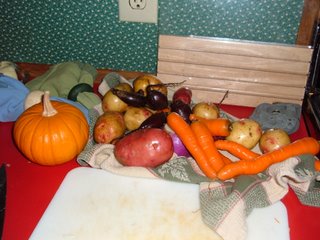Recipe Corner:I love sheperd's pie because it can include any veggies you might have on hand. I use this recipe as a launching point and every time I make it, it's a little different. This page in my cookbook is riddled with notes and splatters from some good cooking. As a fairly staunch eggplant non-eater (I know, it's blasphemy. . . but I can't stand the stuff), I leave it out and add all kinds of other stuff. Included in my list of extras are: summer squash, roasted winter squash, corn, carrots, broccoli, extra celery, tofu crumbles (the frozen fake ground beef stuff), crumbled veggie burgers, bok choi, kale or other greens or anything else that's on hand. Yum! This recipe is really kid-friendly without the sauce. However, I think the Dilled Horseradish Sauce is what makes this really stand out as a favorite. Put the straight horseradish on the table for those who really want to clear their noses!
SHEPHERD'S PIE
Adapted from
The Enchanted Broccoli Forest by Mollie Katzen
Preparation time: 45 minutes, plus 30 minutes to bake.
Yield: 4 to 6 servings
A deep-dish casserole with vegetable hash on the bottom and garlicky mashed potatoes on top.
Mashed Potato Topping
(Make this first):
2 large potatoes.
1 tablespoon butter.
1/2 cup milk.
3 large cloves garlic, minced.
Salt and pepper to taste.
1/2 cup minced fresh parsley
Peel or scrub the potatoes, and cut them into 1-inch chunks. Cook in plenty of boiling water until soft. Drain and transfer to a medium-large bowl. Add the butter, garlic, and milk and mash well. Add salt and pepper to taste, and stir in the parsley. Set aside.
Vegetable Hash:
1 tablespoon olive oil
1 1/2 cups minced onion
4 large cloves garlic, minced
1 teaspoon salt
Freshly ground black pepper
1 stalk celery, minced
1 pound mushrooms, chopped
1-pound eggplant, diced
1 medium bell pepper, minced
2 teaspoons dried basil
1/2 teaspoon dried thyme
1/2 teaspoon dried oregano
1 cup peas (fresh or frozen)
1 cup (packed) grated sharp cheddar
1/4 cup fine bread crumbs
3 tablespoons cider vinegar
Cayenne to taste
Paprika for the top
Dilled Horseradish Sauce (recipe follows)
1. Preheat the oven to 350 ºF. Lightly spray a 2-quart casserole or its equivalent with nonstick spray. (You can also use a 9 x 13-inch baking pan).
2. Heat the oil in a large, deep skillet. Add the onion andsauteté over medium heat for about 5 minutes, or until it begins to soften.
3. Add garlic, salt, pepper, celery, mushrooms, eggplant, and bell pepper. Stir until well combined, cover, and cook over medium heat for about 10 minutes, stirring frequently. Add the herbs, stir, and cover again. Cook for about 5 more minutes, or until the eggplant is perfectly tender. Remove from heat.
4. Stir in the peas, 1/2 cup of the cheddar, the bread crumbs, and the vinegar. Add cayenne to taste. Spread this mixture into the prepared casserole or baking pan.
5. Spoon and/or spread the mashed potatoes over the vegetables. Sprinkle the remaining cheddar on top, and dust with paprika.
6. Bake uncovered for 25 to 30 minutes, or until lightly browned on top and bubbly around the edges. Make the sauce while the casserole bakes. To serve, spoon a little sauce onto each plate. Add a chunk of "pie" potato side-up, and spoon extra sauce over the top. Serve hot.
Dilled Horseradish Sauce
2 Tbs. Butter or Canola oil
1-2 Tbs. unbleached while flour (depending on desired thickness)
1 1/4 cups warmed milk
1 TBS prepared horseradish
a scant 1/2 tsp. salt
1 Tbs minced fresh dill
Freshly ground pepper to taste
Melt butter or heat oil in a medium-small saucepan. Whisk in the flour, and cook over low heat, whisking often, for about a minute.
Whisk in the milk, and continue to cook over low heat, whisking frequently for another 5 minutes. Stir in horseradish and salt, and remove from heat. Stir in the dill and black pepper just before serving.



